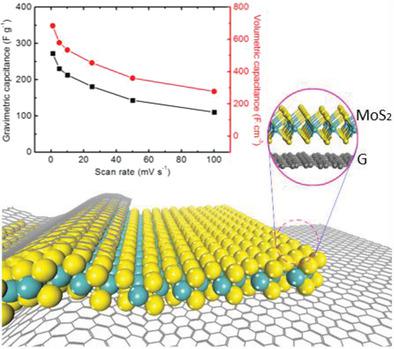Our official English website, www.x-mol.net, welcomes your
feedback! (Note: you will need to create a separate account there.)
Strong Charge Transfer at 2H–1T Phase Boundary of MoS2 for Superb High‐Performance Energy Storage
Small ( IF 13.0 ) Pub Date : 2019-04-24 , DOI: 10.1002/smll.201900131 Qingqing Ke 1 , Xiao Zhang 2 , Wenjie Zang 1 , Abdelnaby M. Elshahawy 1 , Yating Hu 1 , Qiyuan He 2 , Stephen J. Pennycook 1 , Yongqing Cai 3 , John Wang 1
Small ( IF 13.0 ) Pub Date : 2019-04-24 , DOI: 10.1002/smll.201900131 Qingqing Ke 1 , Xiao Zhang 2 , Wenjie Zang 1 , Abdelnaby M. Elshahawy 1 , Yating Hu 1 , Qiyuan He 2 , Stephen J. Pennycook 1 , Yongqing Cai 3 , John Wang 1
Affiliation

|
Transition metal dichalcogenides exhibit several different phases (e.g., semiconducting 2H, metallic 1T, 1T′) arising from the collective and sluggish atomic displacements rooted in the charge‐lattice interaction. The coexistence of multiphase in a single sheet enables ubiquitous heterophase and inhomogeneous charge distribution. Herein, by combining the first‐principles calculations and experimental investigations, a strong charge transfer ability at the heterophase boundary of molybdenum disulfide (MoS2) assembled together with graphene is reported. By modulating the phase composition in MoS2, the performance of the nanohybrid for energy storage can be modulated, whereby remarkable gravimetric and volumetric capacitances of 272 F g−1 and 685 F cm−3 are demonstrated. As a proof of concept for energy application, a flexible solid‐state asymmetric supercapacitor is constructed with the MoS2‐graphene heterolayers, which shows superb energy and power densities (46.3 mWh cm−3 and 3.013 W cm−3, respectively). The present work demonstrates a new pathway for efficient charge flow and application in energy storage by engineering the phase boundary and interface in 2D materials of transition metal dichalcogenides.
中文翻译:

MoS2在2H–1T相界处的强电荷转移,可实现出色的高性能储能
过渡金属二卤化物显示出几个不同的相(例如,半导体2H,金属1T,1T'),这是由于电荷-晶格相互作用产生的集体且缓慢的原子位移引起的。单张纸中多相的共存可实现普遍存在的异相和不均匀的电荷分布。在此,通过结合第一性原理计算和实验研究,报道了在与石墨烯组装在一起的二硫化钼(MoS 2)的异相边界处的强电荷转移能力。通过调制MoS 2中的相组成,可以调制用于能量存储的纳米混合材料的性能,从而显着的重量和体积电容分别为272 F g -1和685 F cm展示了-3。作为能源应用概念的证明,使用MoS 2-石墨烯异质层构建了柔性固态不对称超级电容器,该层显示出极好的能量和功率密度(分别为46.3 mWh cm -3和3.013 W cm -3)。本工作通过设计过渡金属二卤化物的二维材料中的相界和界面,展示了一种有效的电荷流动和在能量存储中应用的新途径。
更新日期:2019-04-24
中文翻译:

MoS2在2H–1T相界处的强电荷转移,可实现出色的高性能储能
过渡金属二卤化物显示出几个不同的相(例如,半导体2H,金属1T,1T'),这是由于电荷-晶格相互作用产生的集体且缓慢的原子位移引起的。单张纸中多相的共存可实现普遍存在的异相和不均匀的电荷分布。在此,通过结合第一性原理计算和实验研究,报道了在与石墨烯组装在一起的二硫化钼(MoS 2)的异相边界处的强电荷转移能力。通过调制MoS 2中的相组成,可以调制用于能量存储的纳米混合材料的性能,从而显着的重量和体积电容分别为272 F g -1和685 F cm展示了-3。作为能源应用概念的证明,使用MoS 2-石墨烯异质层构建了柔性固态不对称超级电容器,该层显示出极好的能量和功率密度(分别为46.3 mWh cm -3和3.013 W cm -3)。本工作通过设计过渡金属二卤化物的二维材料中的相界和界面,展示了一种有效的电荷流动和在能量存储中应用的新途径。


















































 京公网安备 11010802027423号
京公网安备 11010802027423号